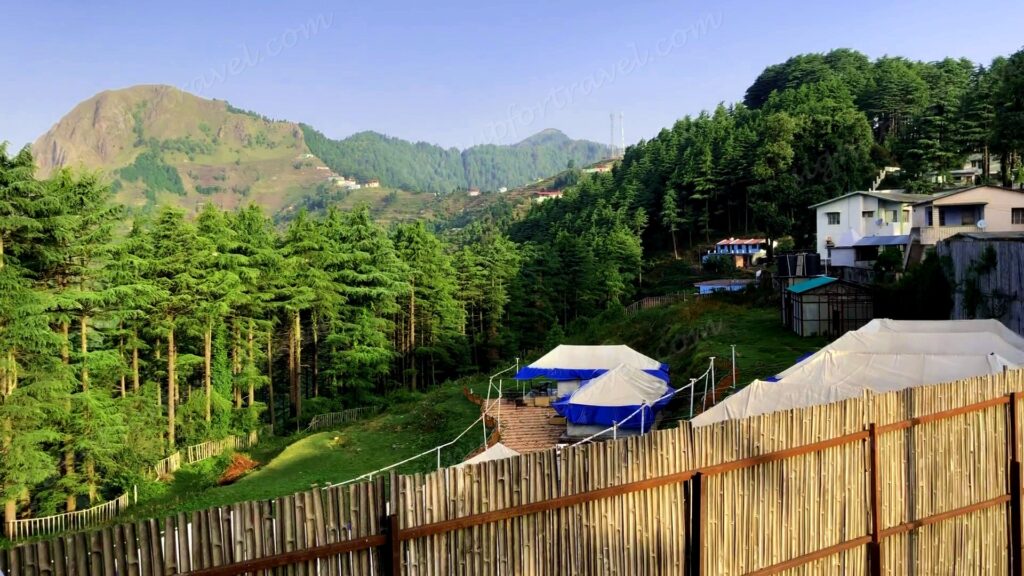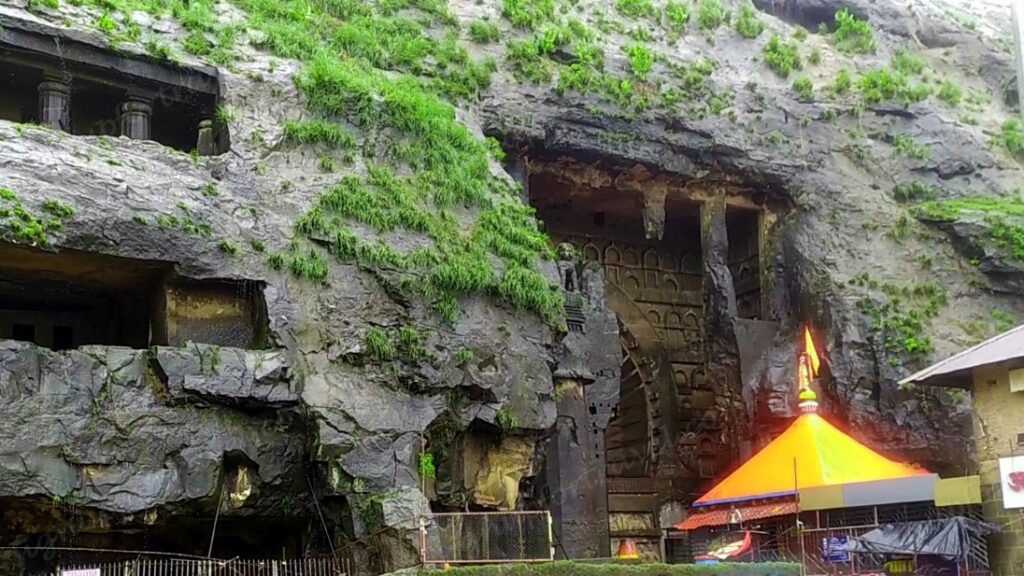Table of Contents
- An early start
- Country roads with great views
- Aihole – Initial thoughts
- Durga temple complex – Main temple
- Durga temple complex – Other temples
- Ravanaphadi
- Reaching Pattadakal
- A brief about Pattadakal
- Our experience at Pattadakal
- Lunchtime!
- Bhootnath temple in Badami
- Return to Pune
- Final thoughts
- Link to Aihole Temples YouTube video
- Link to Pattadakal Temples YouTube video
1. An early start
We finally got to the last day of this trip, and we had to cover two places i.e., Aihole and Pattadakal. With that in mind, we decided to start early. We woke up at 5.30 AM and were out on the bike at 6.30 AM.
An early start always has a couple of benefits if not more – virtually no traffic and friendly weather. We reaped both benefits as we rode out of Badami. The plan was to first ride to Aihole and then cover Pattadakal on the way back.
The early morning weather was amazing and in fact, we were feeling a bit cold while riding.
2. Country roads with great views
As we rolled out of Badami, the scenery was mind-blowing. We had taken this same route while coming in but then it seemed completely different in the early morning glow.
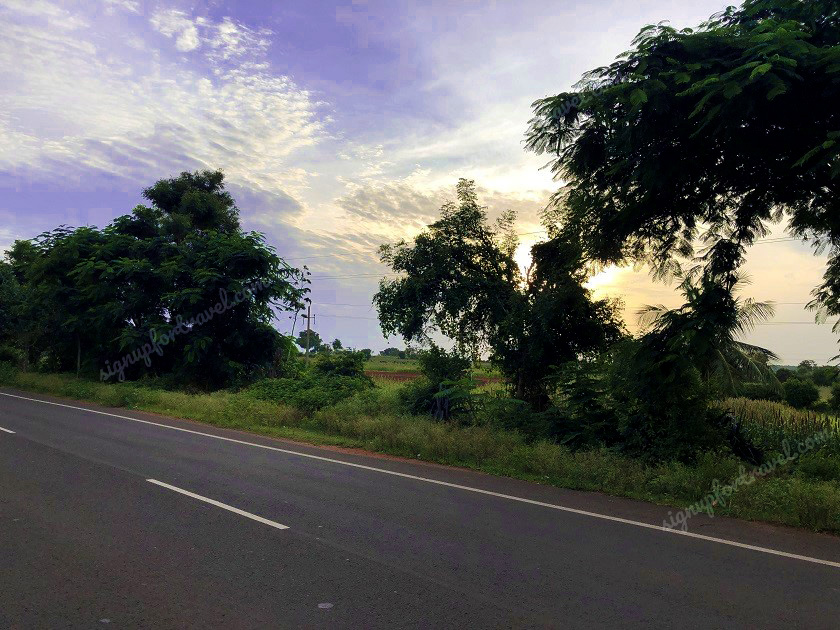
The road is a two-lane one without any dividers, but it is smooth for the most part. The road is lined with trees and open lush green fields on either side with small hills at a distance. There are several small villages in between.
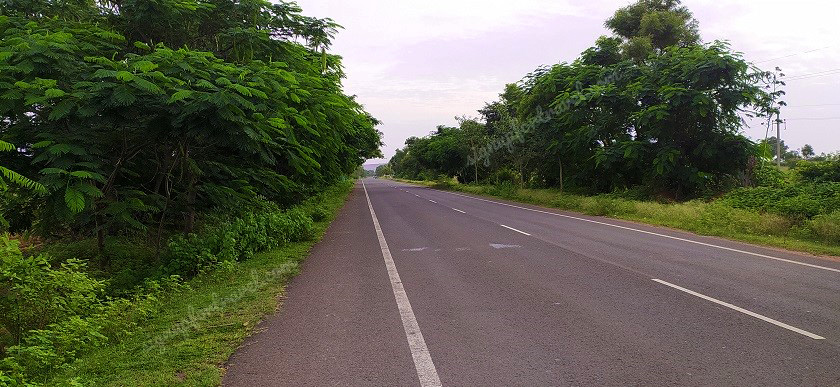
With villages on the way came another problem. Not with traffic or stray cattle but with the people answering calls of nature along/on the road. Our country has come a long way in addressing these issues but then we still have some way to go. This, however, did not take anything from our experience of riding through some beautiful landscapes.
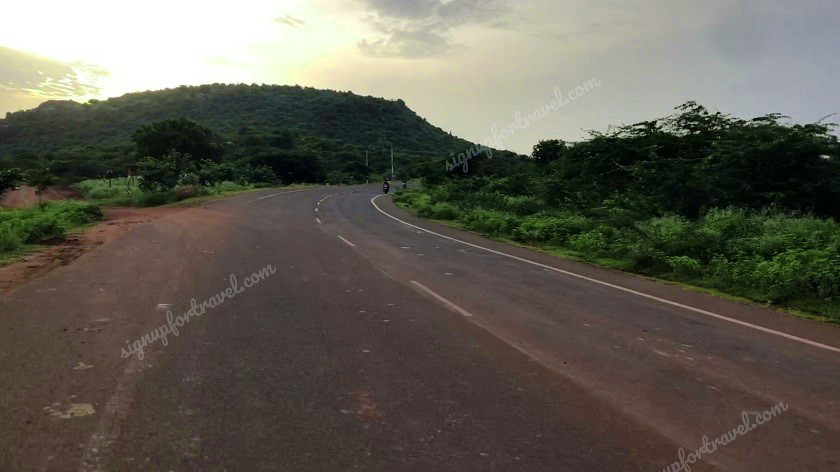
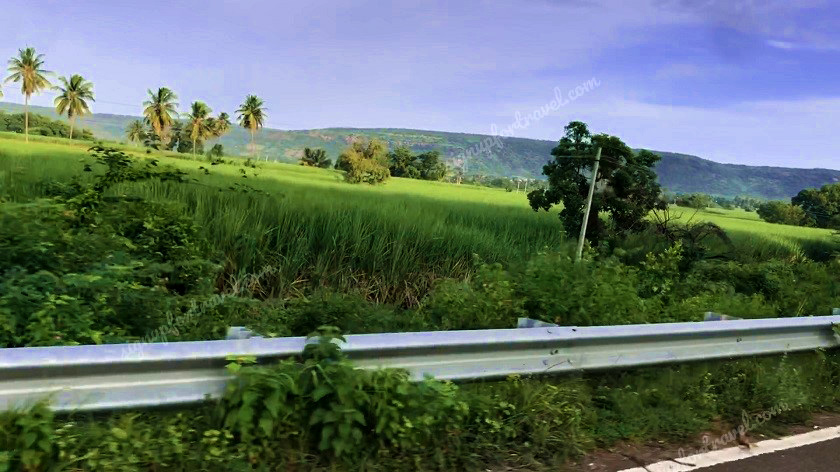
3. Aihole – Initial thoughts
We reached Aihole at around 7.30 AM covering a distance of 35 km from Badami. There are roughly 120 temples in this small village though most of them are not in a good condition. The temples here date back as early as the 5th century, so from a historical perspective, it is very significant.
We also found that this is an active village, meaning that people co-exist with these historically significant monuments. Most of these ancient structures remain open to violation by humans as they are without a secured perimeter. We saw a villager sharpening his tools on one of these temples.
The complexes which have secured perimeters and are maintained by the ASI, remain open from 6 AM to 6 PM.
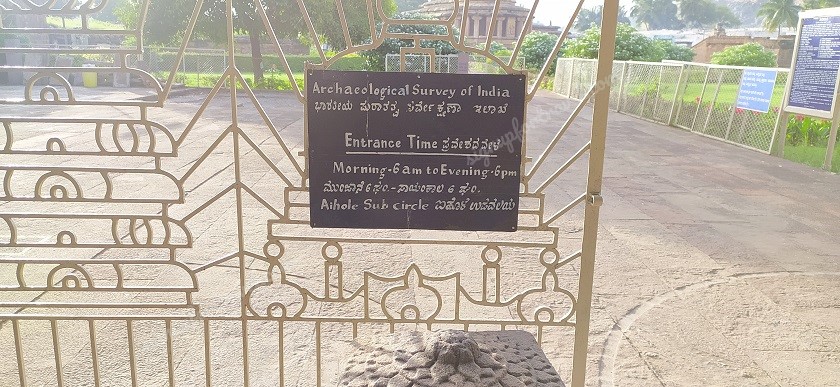
With so many temples in one single place, if you were to explore all of them then it would require at least a day. As we had limited time, we decided to visit only important places.
4. Durga temple complex – Main temple
This is one of the more famous ones in Aihole and is preserved as well as it can be. It has a parking area outside and is a gated complex. The entry tickets cost Rs.50 for both of us. Upon entry into the complex, we saw some beautifully manicured lawns with jasmine trees alongside the paved path.
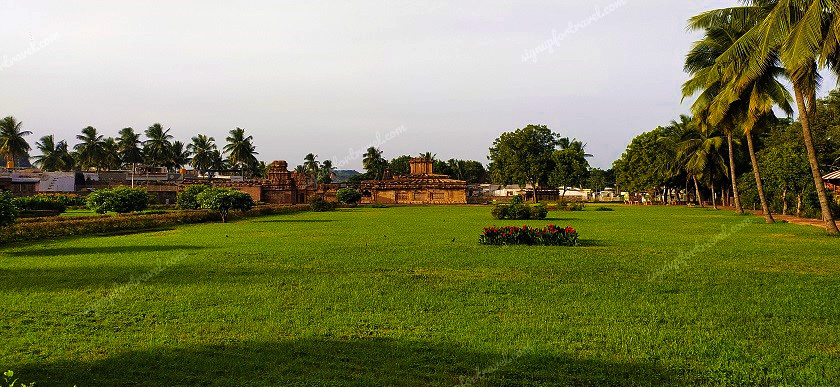
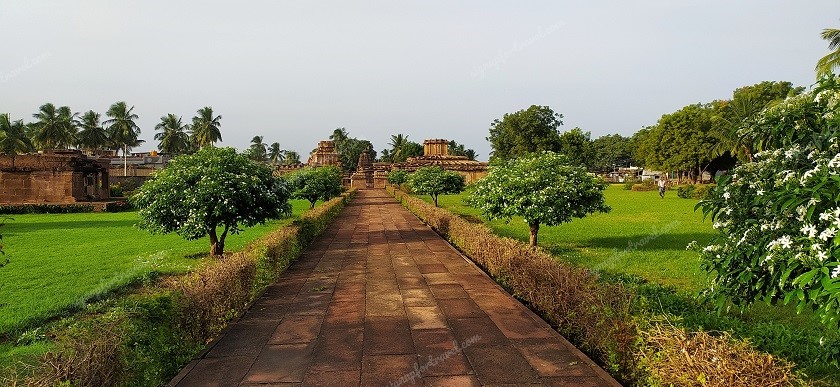
On moving ahead, we saw the main structure i.e., the Durga temple.
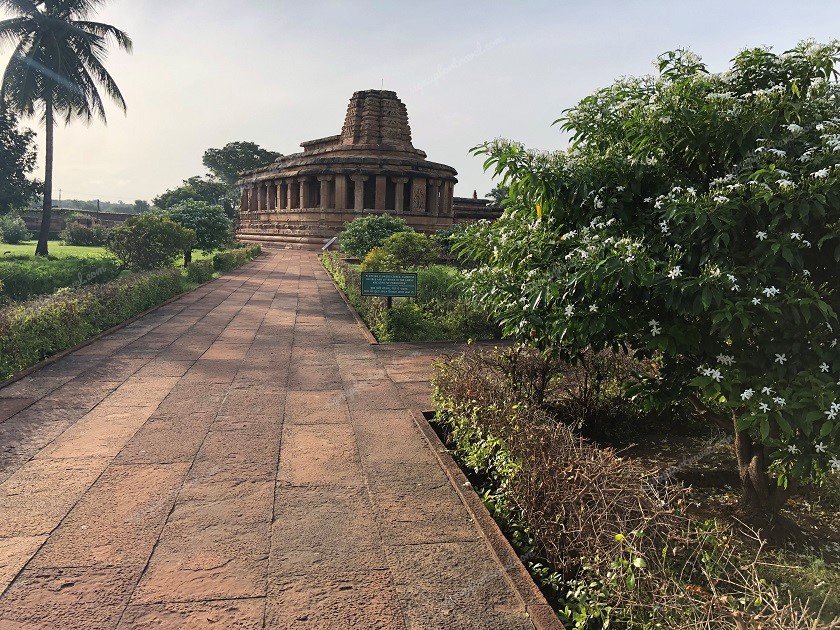
One interesting fact about this temple – it is not dedicated to the goddess Durga. According to a theory, since it stands near the ruins of a fort-like enclosure, it is named as such (Durg means fort).
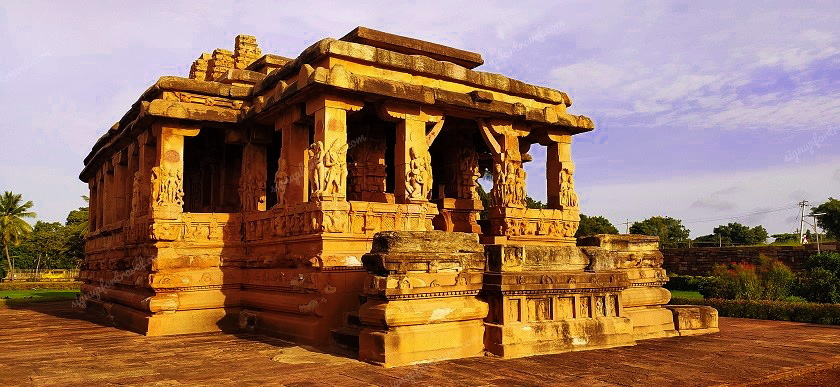
The temple can be entered through stairs from the north and the south. At first look, the shikhara of the main temple structure is partly damaged. But considering how old the temple is, it is still in a good condition.
We read from different sources that the temple was originally dedicated to the sun god Aditya. There are several carvings on the pillars, some of that of amorous couples and some of the gods. Some of the carvings and sculptures found in the temple belong to different avatars of Vishnu like that of Narasimha, and Varaha. One can also see sculptures of Shiva leaning on Nandi, Vishnu riding Garuda, Harihara and Ardhanari. Apart from these sculptures of Gods, there are also depictions of some episodes of Ramayana.
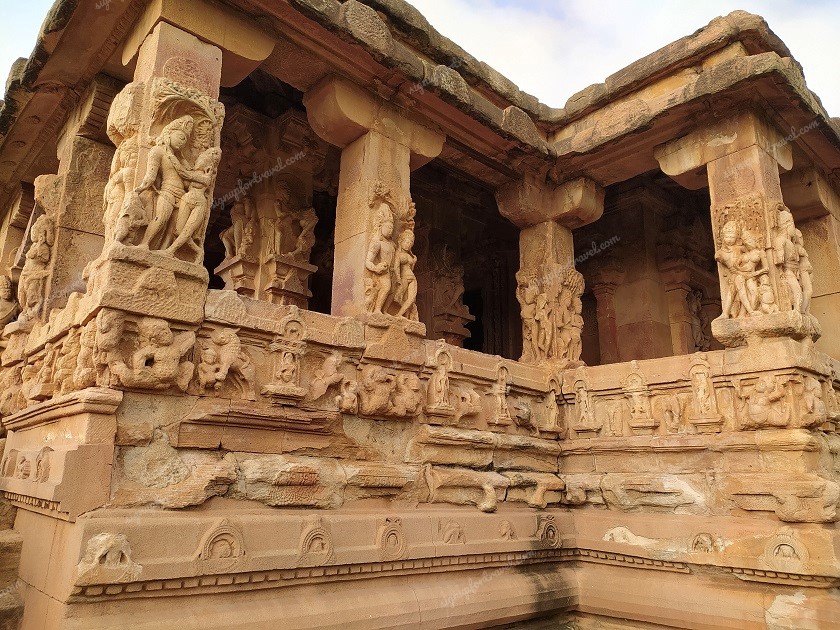
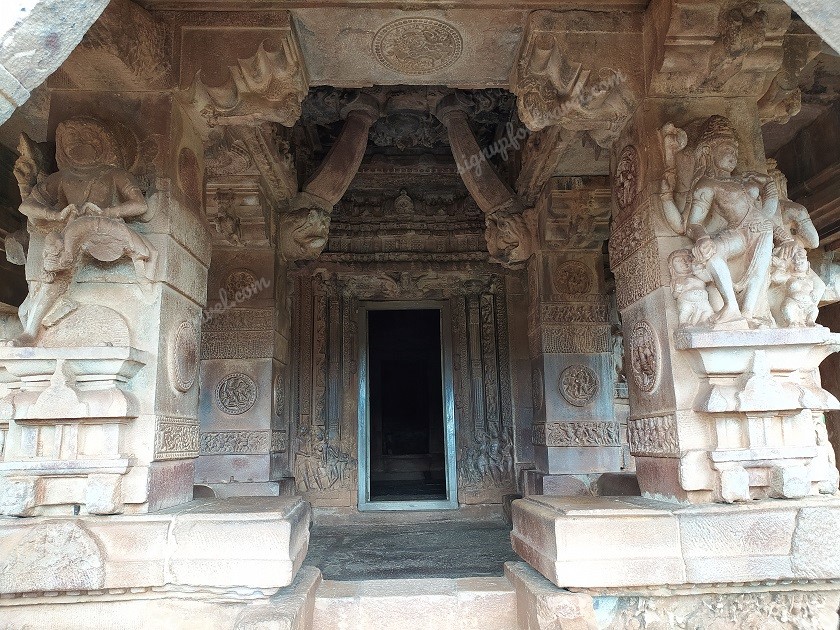
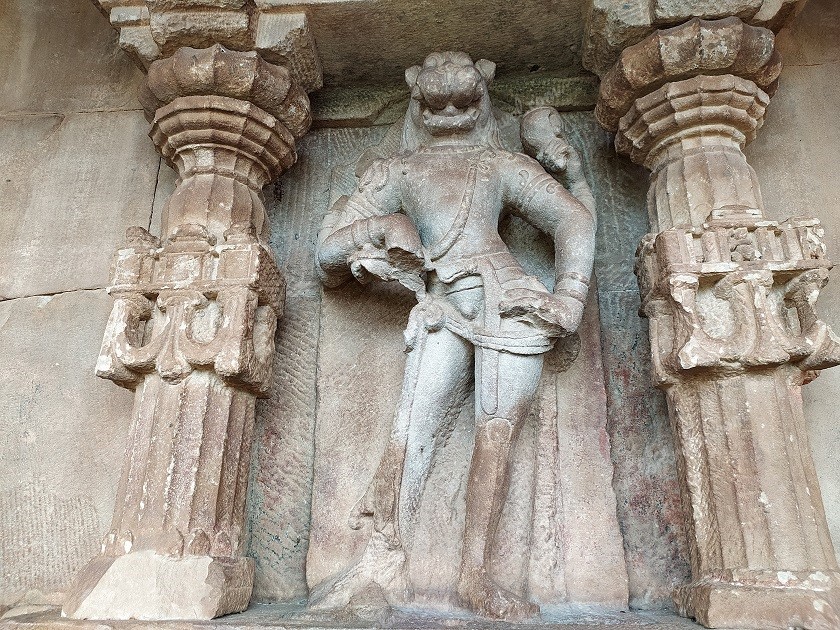
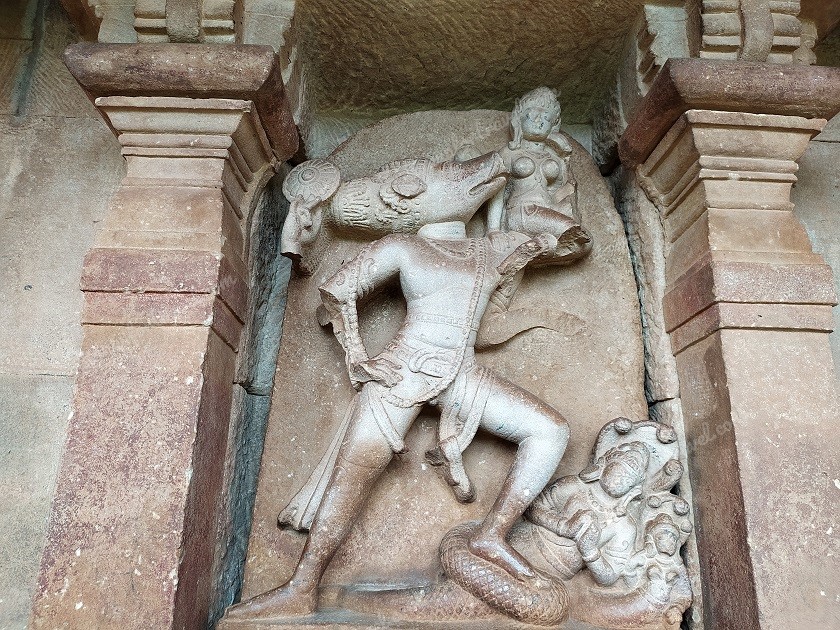
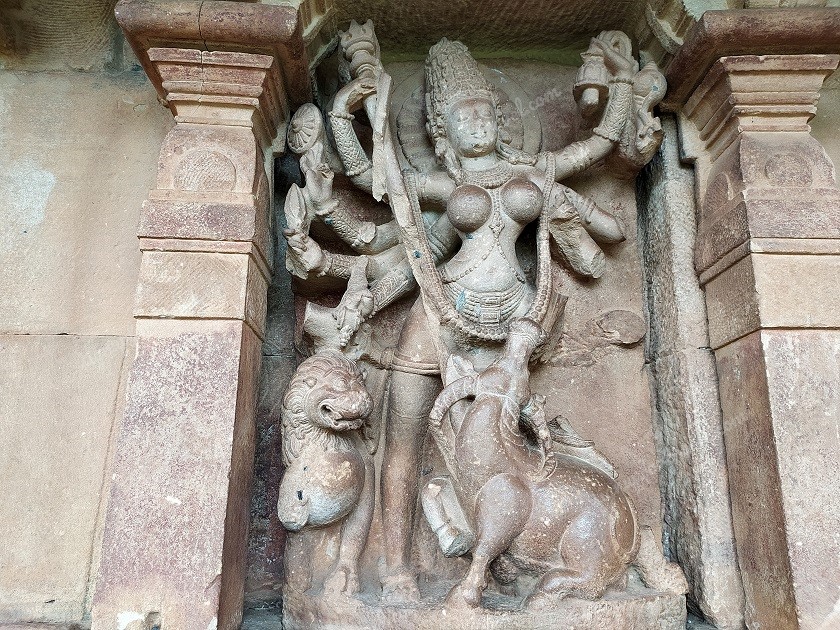
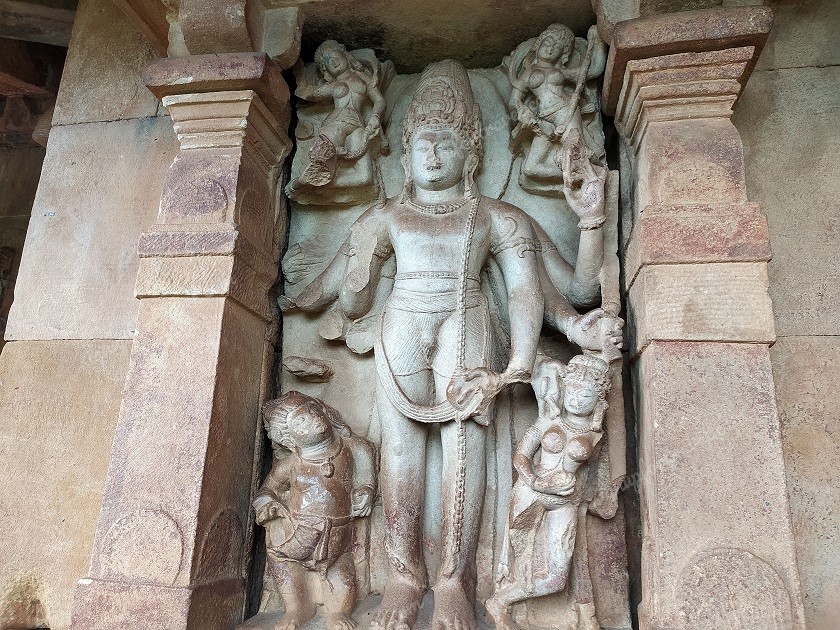
5. Durga temple complex – Other temples
Next to the Durga temple is the Suryanarayana temple with a Surya statue, most of the structure is now in a damaged state.
Then there is Lad Khan temple (the name is kind of misleading). It is most probably named after a Muslim commander who stayed here briefly. The temple is dedicated to Lord Shiva so you will find a Shiva Linga and Nandi inside the structure.
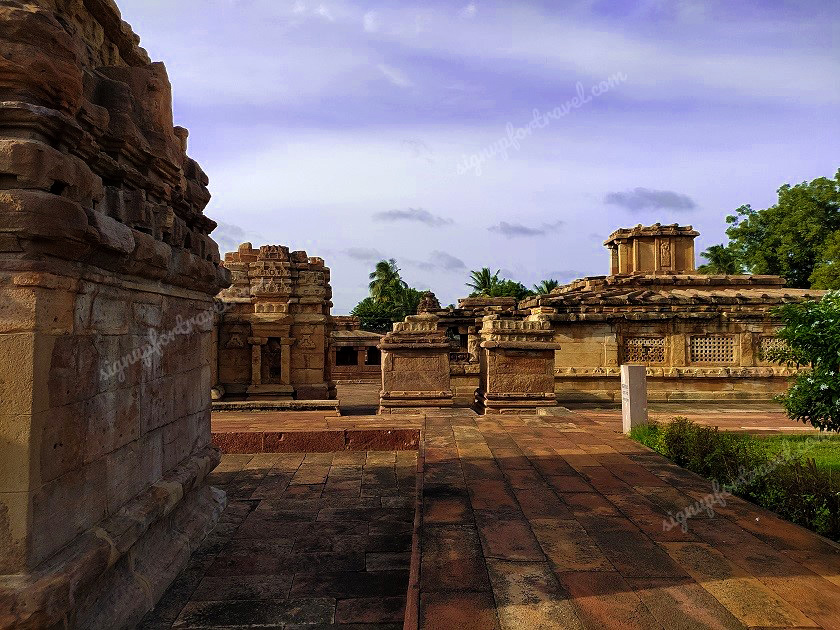
Next to the Lad Khan temple is Gaudara Gudi. The temple stands on an elevated pedestal and has some carvings on the door frame. The inner sanctum is though empty.
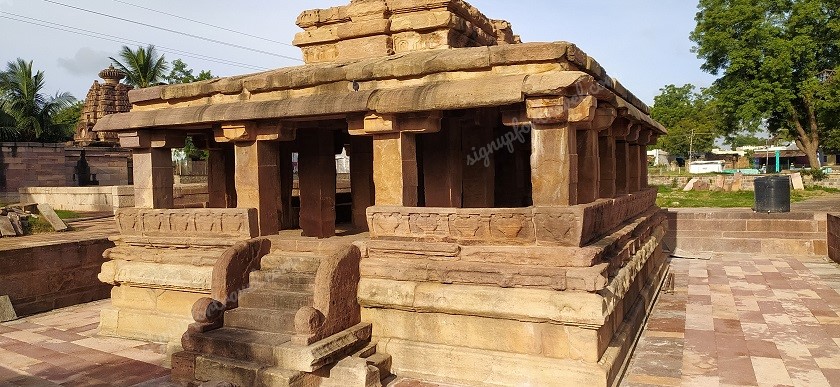
There is a step well next to Gaudara Gudi which we believe was mainly used for storing water. There are some carvings on the walls of this stepwell.
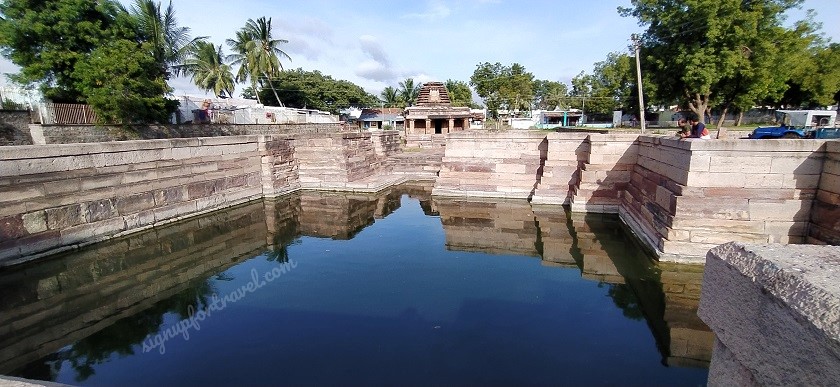
The last temple in this complex is the Chakragudi. It consists of a sanctum, a hall and an open mandapa. Again, not much left in the temple.
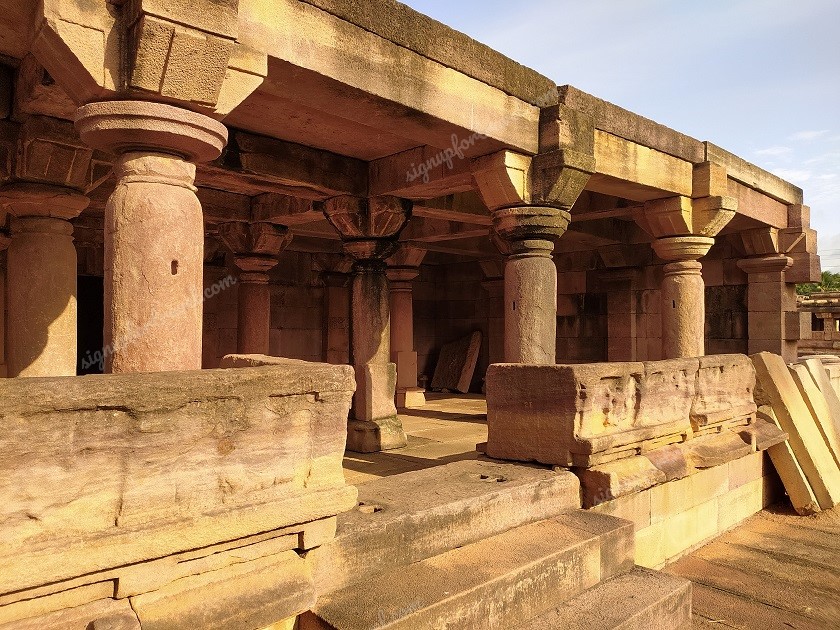
Then, finally, there is an ASI-run museum in the complex. We had to skip this one as the opening time was 9 AM. However, there were several sculptures on display outside the museum, so we spent some time studying the idols of Ganesha and other deities.
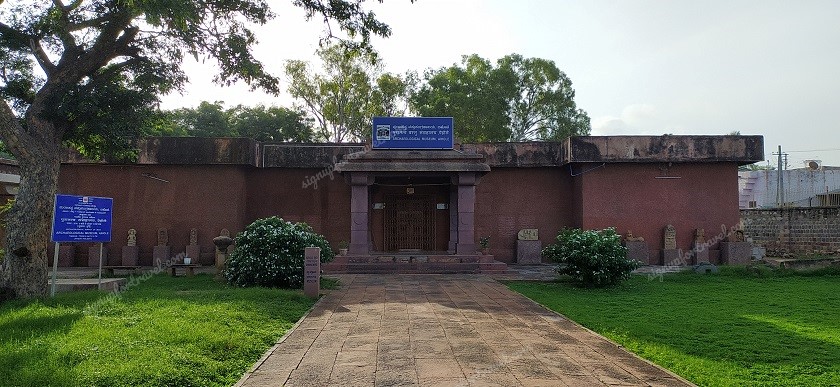
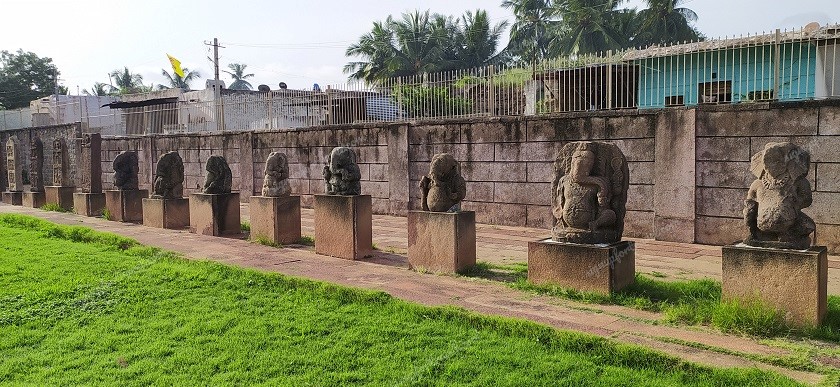
6. Ravanaphadi
We spoke to the guard of the Durga temple complex who suggested that we visit the Ravanaphadi temple. This temple was a couple of kilometres away, so we proceeded towards it. There are no specific signages on the road that leads to this temple, so you have to ask around. We took a detour off the main road to an unpaved one which leads to this temple.
As soon as entered this unpaved road, we saw a temple named Huchchimalli. It is a gated complex but there was nobody around except for some stray cattle happily grazing its lawn and a dog enjoying the soft grass. The main temple itself is built on an elevated platform and has stairs leading to the sanctum. As per the board outside the complex, this temple is dedicated to Lord Shiva.
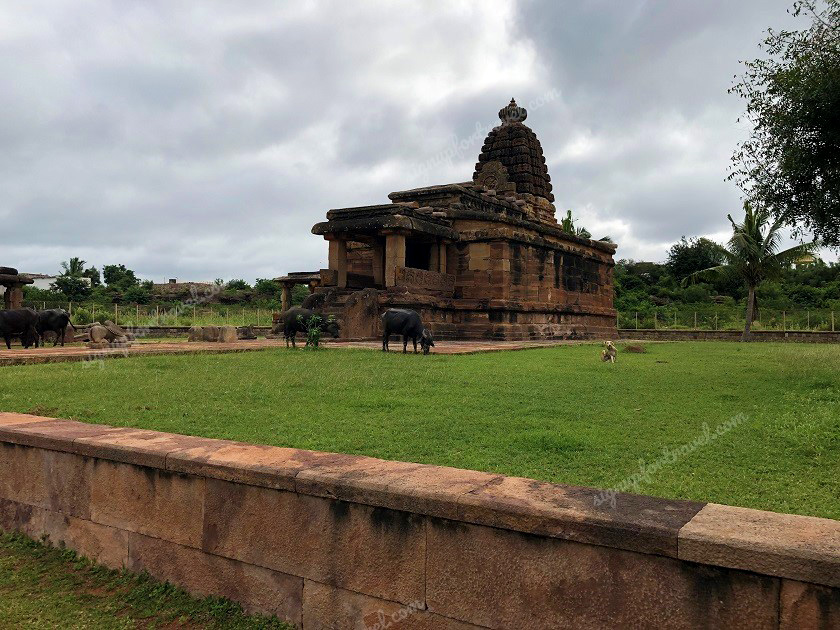
We proceeded further on this road and reached Ravanaphadi. It is a cave shrine but smaller than the ones we saw in Badami. The exterior is supported by four pillars and has carvings of the guards.
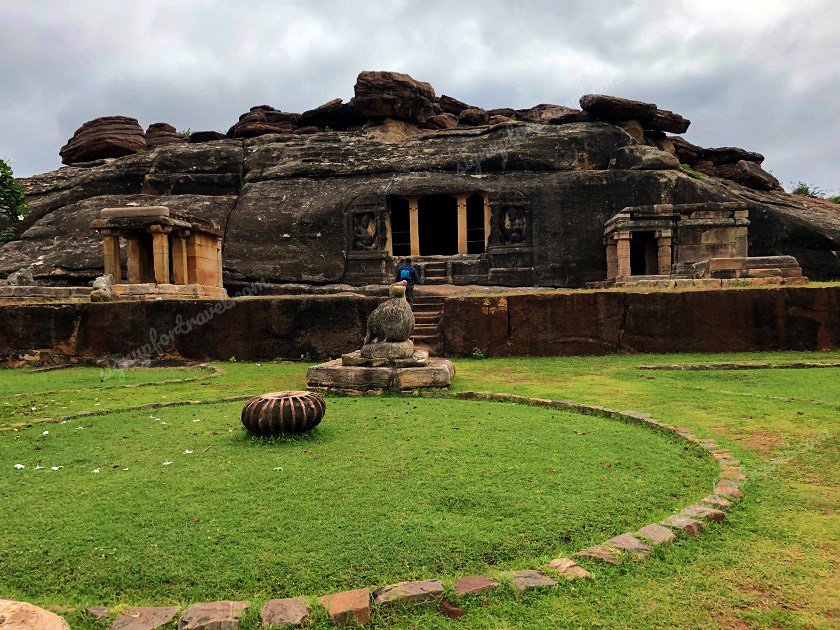
The interior has a sculpture of a dancing Shiva with ten hands. It also has figures of Varaha and Mahishasuramardini among other carvings. The inner sanctum has a Shiva Linga and on the outside is a seated Nandi on a small platform.
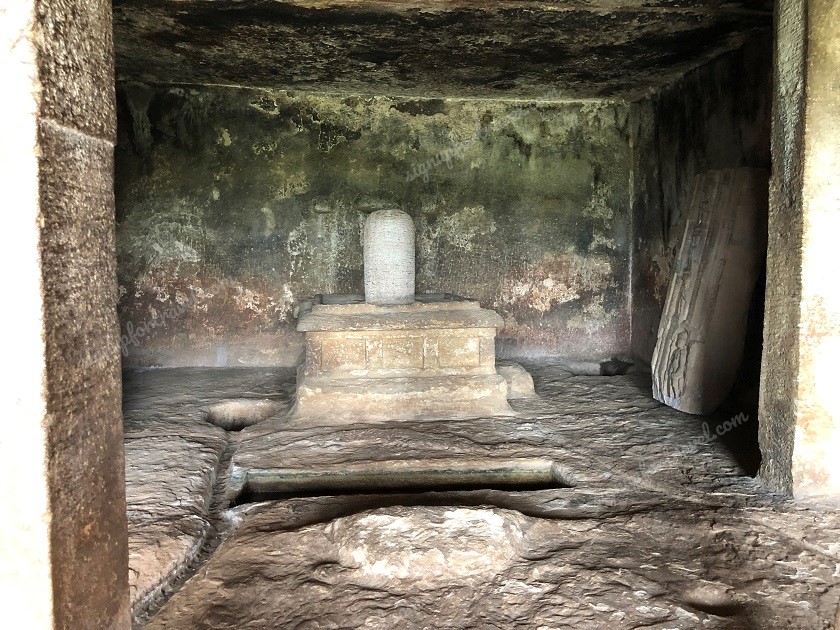
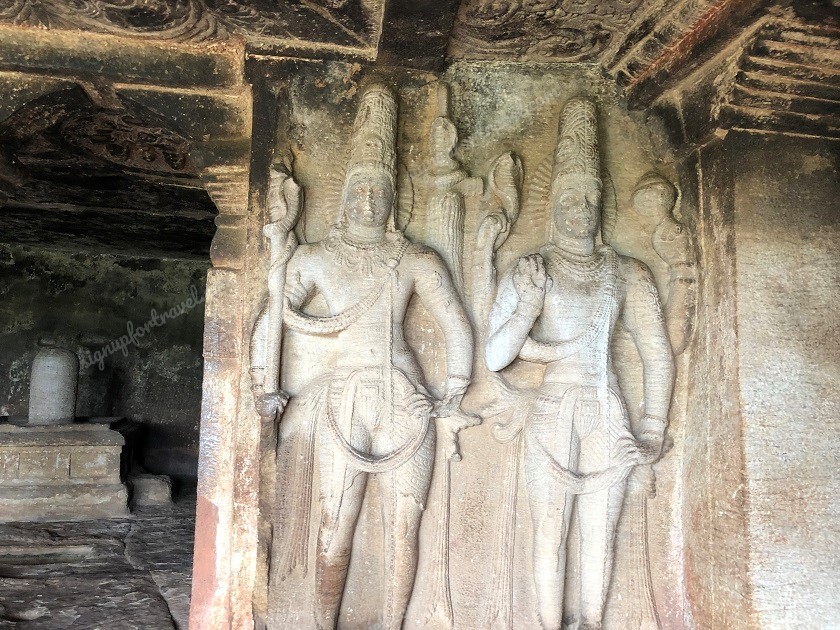
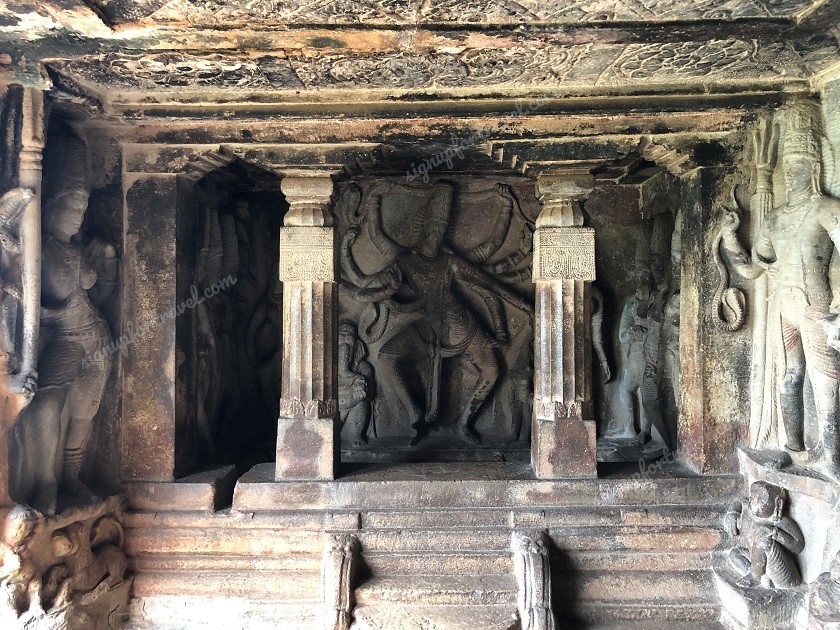
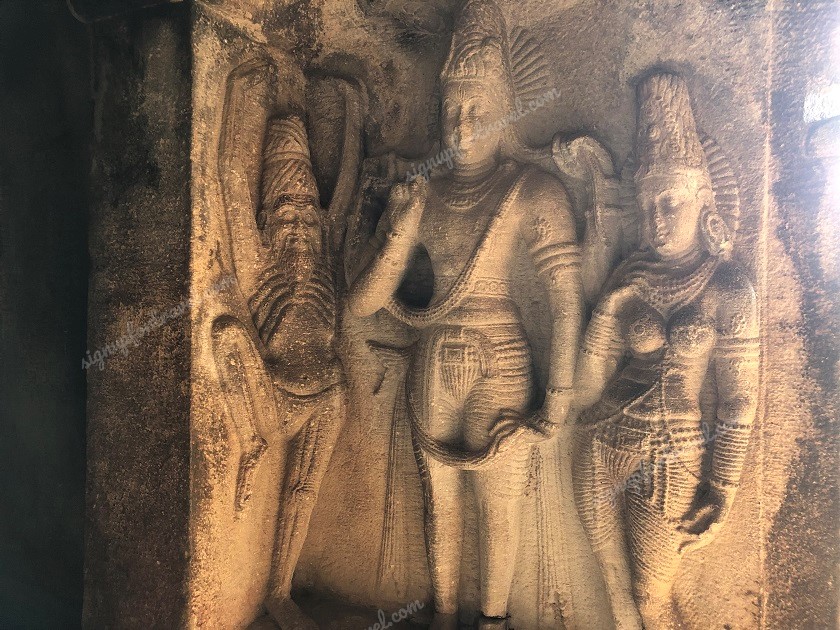
We did not plan for this place, but the experience was good with the structure being away from civilization. The time was roughly 9 AM and we were done with our Aihole exploration and ready to proceed to our next destination.
7. Reaching Pattadakal
We went back the same way and reached Pattadakal in about 20 minutes. The whole complex is housed in a single enclosure. Though it is also a village, it is isolated from the outside (thank God for that!). There are few shacks outside the complex selling food and other refreshments. You will also find a lot of local villagers selling their homemade stuff like buttermilk etc. outside the complex.
We purchased the entry tickets for ourselves and the camera, which cost us Rs.75. and then entered the temple complex past the ticket window and soon were greeted by guides. We were in two minds, whether we should opt for one or not. The guides were quoting a slightly higher charge than we expected so we thought of not hiring one. But they chased us and agreed to a lower amount, so we finally fixed one at Rs.300. You may just take this as a guideline as it may vary depending on the time of the year and the details that you are looking for. There are so many stories inside the monument that we highly recommend that you hire one.
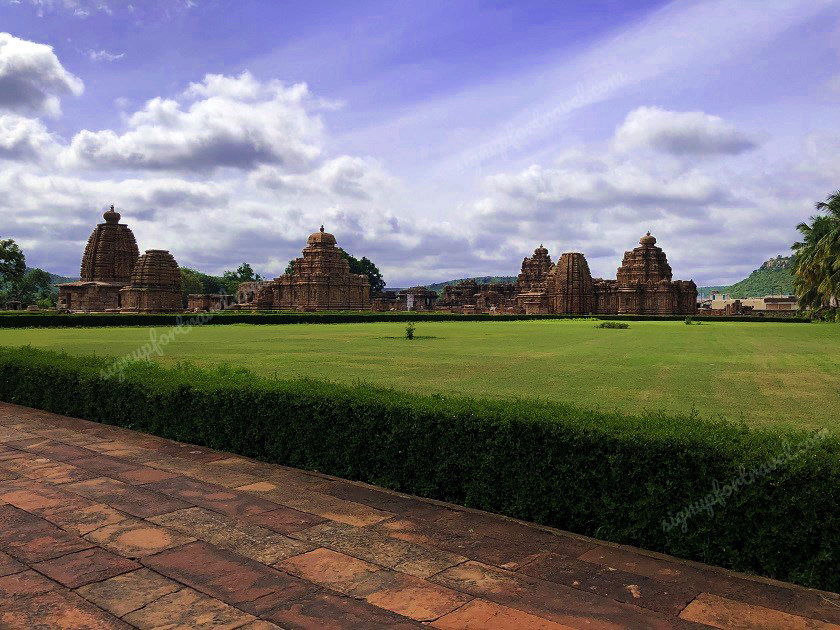
8. A brief about Pattadakal
Pattadakal’s group of monuments is listed as one of the 40 UNESCO world heritage sites in India. In earlier times, it was known as Raktapura or Kisuvolal signifying the red soil found in the region. It, later on, came to be known as Pattadakallu meaning the place where the coronation ceremonies were held. Pattada means coronation, a place where the ceremonies of several Chalukya kings were held. This place was considered a cultural centre of the Chalukya dynasty.
There are a total of eight temples within the complex and all are dedicated to Lord Shiva. The monuments inside represent two main styles namely the Rekha Nagara Prasada (North Indian) and Dravida Vimana (South Indian). This complex is situated on the banks of the river Mallaprabha and this river flows from south to north, hence it is considered a very holy place (normally rivers flow from north to south).
The temples of Kadasiddeshwara, Galaganatha, Jambulinga and Kashivishwesara represent the Rekha Nagara style. Sangameshwara and Virupaksha temples represent the Dravidian style, and the Mallikarjuna temple is a fusion of both styles. Virupaksha and Mallikarjuna temples were known as Lokamahadevi and Trailokamahadevi temples in earlier times named after the wives of King Vikramaditya II. These are identical temples only from the outside, though the Virupaksha temple is a much larger one.
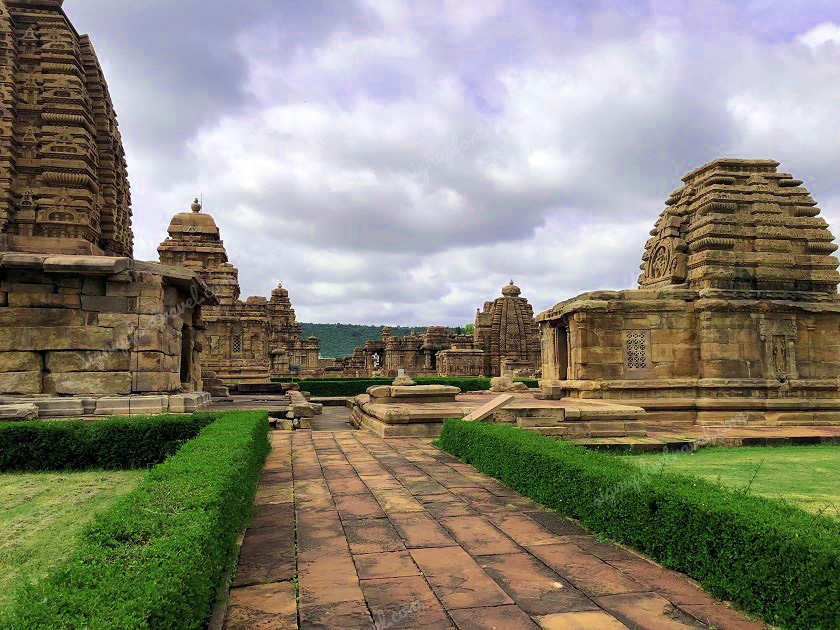
9. Our experience at Pattadakal
As soon as we entered the complex, we felt magically transformed into a different era. Being a UNESCO world heritage site, the whole complex in Pattadakal is extremely well maintained. From the well-manicured lawns at the entrance to the cleanliness all around, everything looked picture-perfect.
As mentioned earlier, there are eight temples inside the complex. They have been built as per the Vaastu shastra so you will find all of them facing east.
Out of the eight temples in the complex, seven of them are damaged in one form or another. Only the Virupaksha temple remains whole, so it is still a live temple where puja is performed. One thing that struck us was the Shiva Linga in all the temples, it is made of green granite stone. We could not believe that it could be so old, it looks beautiful and as good as new.
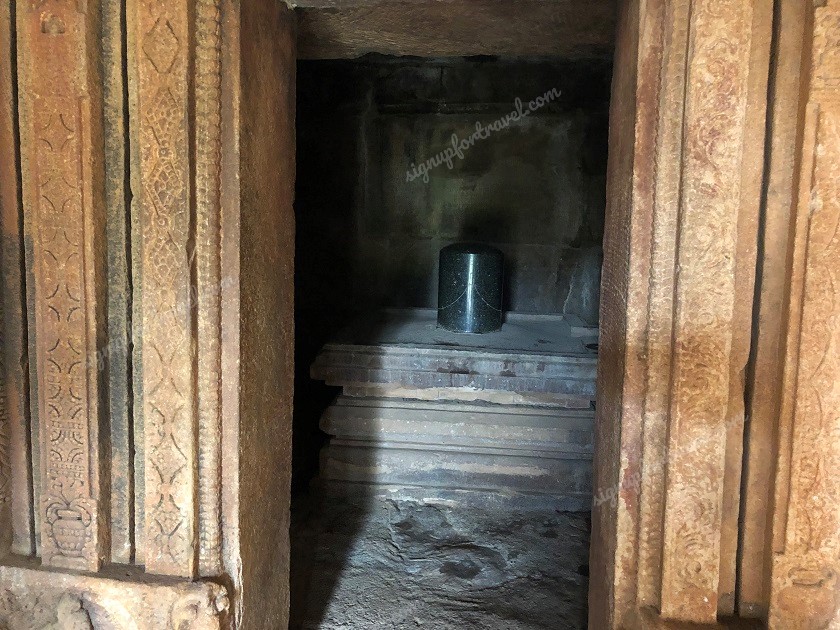
We hopped from one temple to the next marvelling at the intricate carvings and the sculptures while listening to the various stories around them.
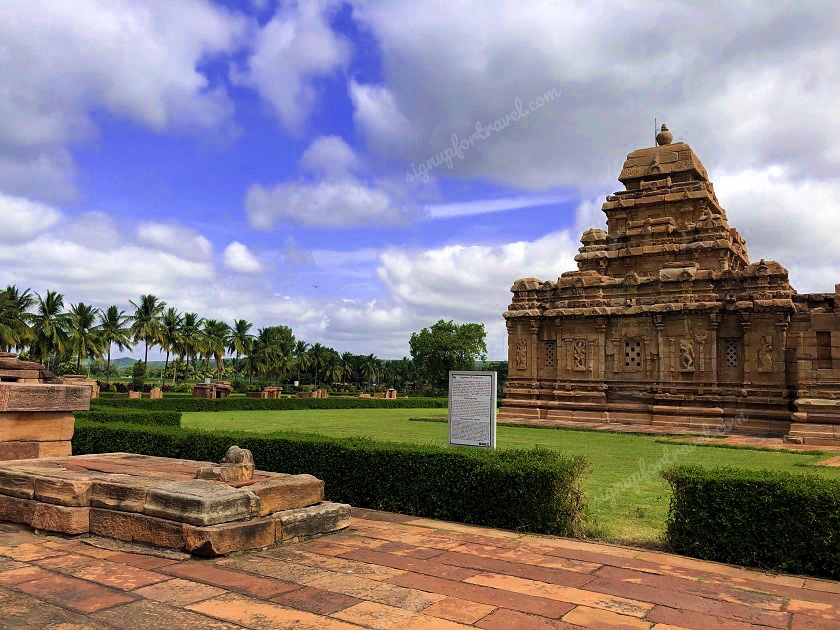
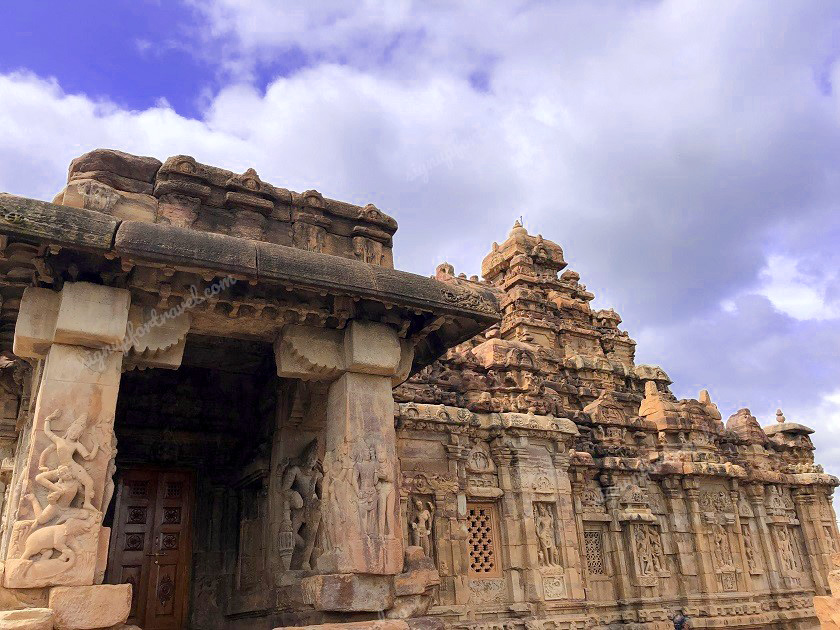
We saw a large Nandi statue (again made of green granite) opposite the main entrance of the Virupaksha temple. As it is a live temple, one has to leave their footwear outside. We went inside and paid our respects to the deity. Just beside the sanctum, we saw a small shrine dedicated to Mahishasuramardini.
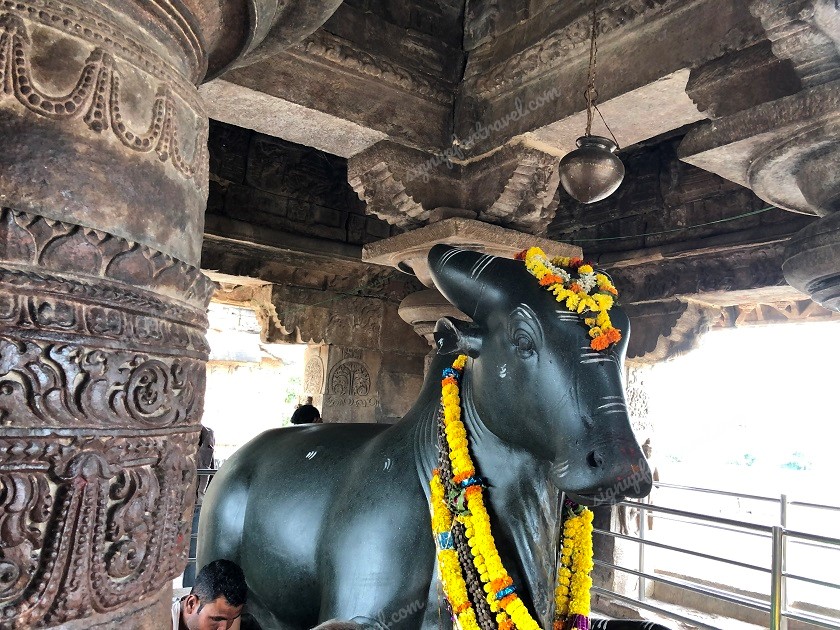
The carvings on the inside and outside of the Virupaksha and Mallikarjuna temples are at a different level. The pillars and walls on the inside tell tales from the great Indian epics, Ramayana and Mahabharata, and document other events and stories as well. As enlightened by our guide, these reliefs were meant to serve as knowledge-sharing instruments for visitors.
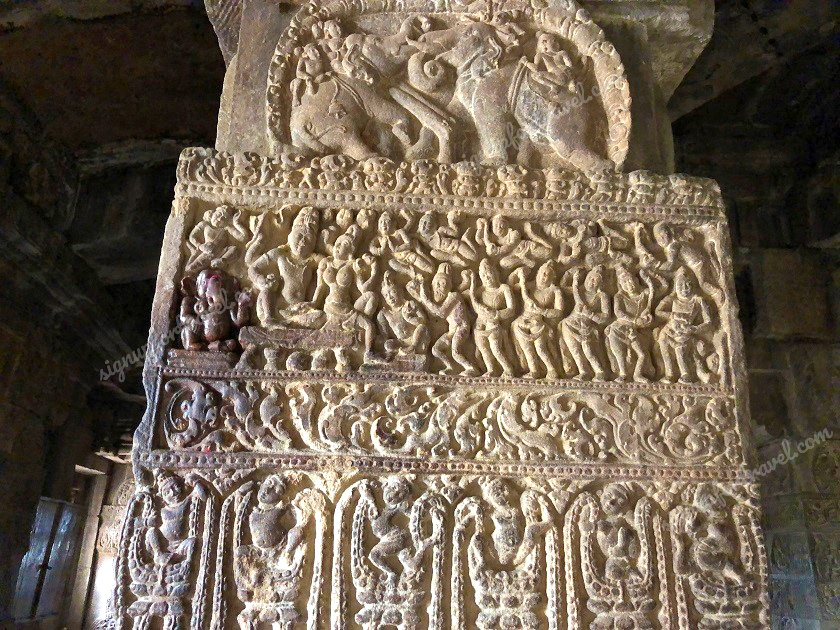
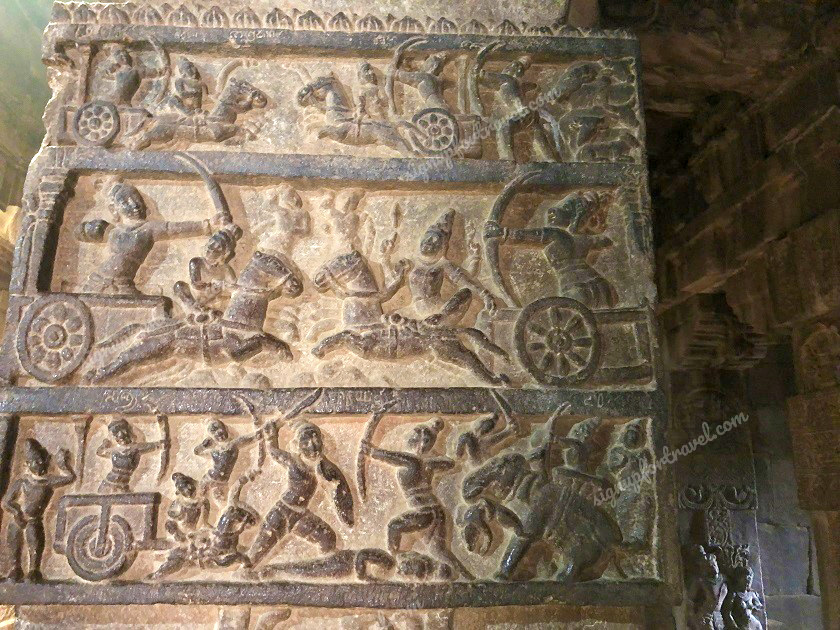
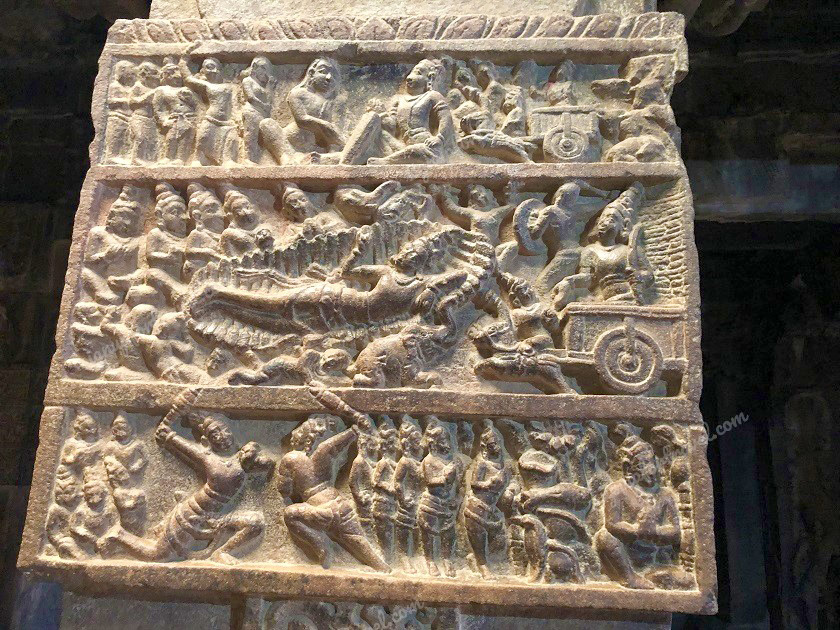
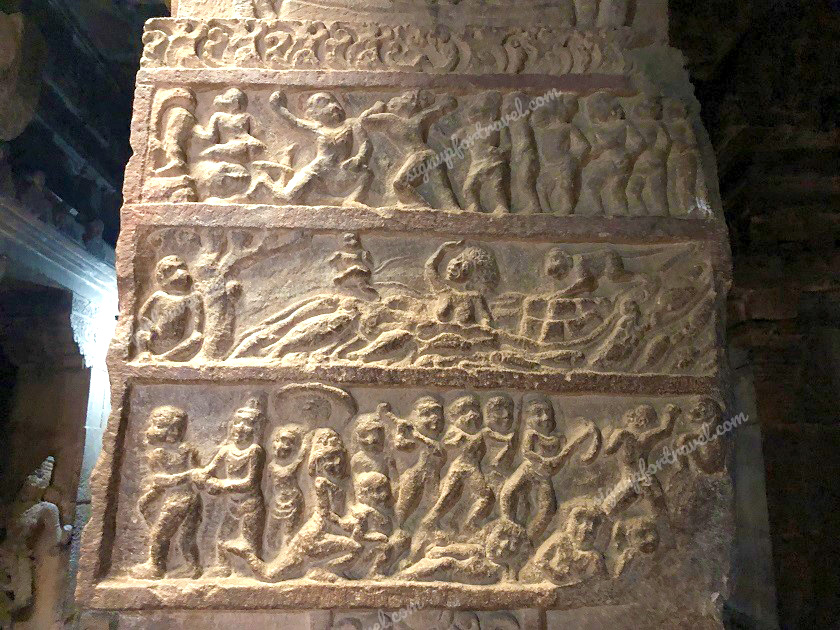
We could also see the river Mallaprabha flowing alongside. But we did not visit the ghat.
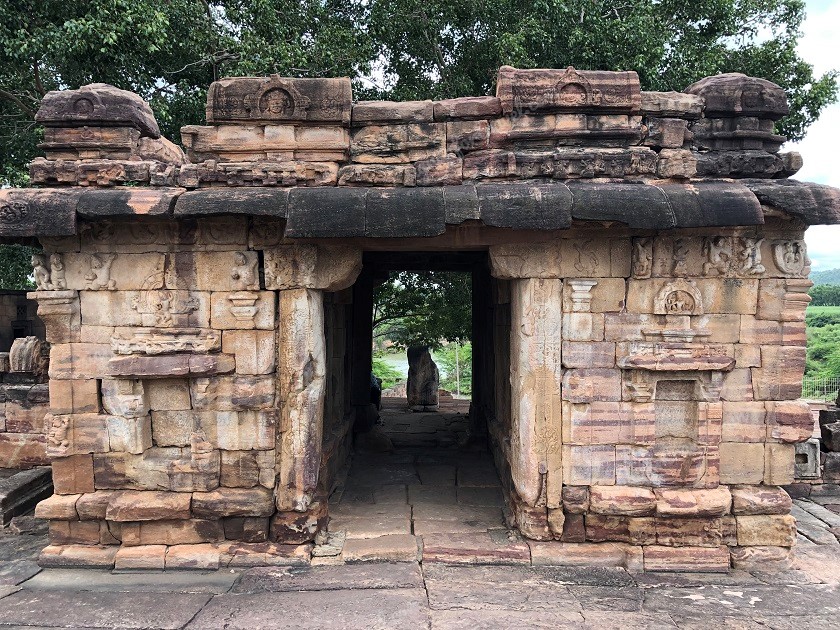
10. Lunchtime!
We would have stayed in the complex exploring various carvings and listening to the stories from our guide till 11 AM. As we did not have breakfast in the morning, there were rumbles from our innards.
We came out of the complex and went to the shacks opposite the complex for lunch. We had jawar roti, rice and sabzi and it cost us Rs. 180, a bit on the higher side. The taste was decent enough. It was the first time for us with jawar roti from this area, so we mistook it for papad and were waiting till we got our lesson (it was kind of funny).
Just a word of advice for tourists, we could not find any decent hotel/Dhaba etc. in the area around Aihole/Pattadakal so do not expect much.
11. Bhootnath temple in Badami
After our lunch, it was time to head back to Badami. We had one thing left to cover that was the Bhootnath temple in Badami (remember the temple on the shore of Agastya Lake). Though the time was roughly around noon, and we had to go back to Pune as well, we still decided to cover this. The scene from the top of the Badami caves (read our Badami caves blog) was enticing enough for us and we fell for it.
On entering Badami, there is a narrow way that leads to the temple. If you don’t look carefully then you will surely miss the turn for the temple.
We took our bike to the parking area for the temple and walked further along the banks of Agastya Lake. People with cars may find it difficult to reach this place. Another option is the leave the vehicle near the caves and cover the remaining distance on foot.
While walking on the banks of the lake, we saw local villagers washing their clothes in the lake, the result of probably not having access to water or sanitation but surprisingly the lake itself was clean.
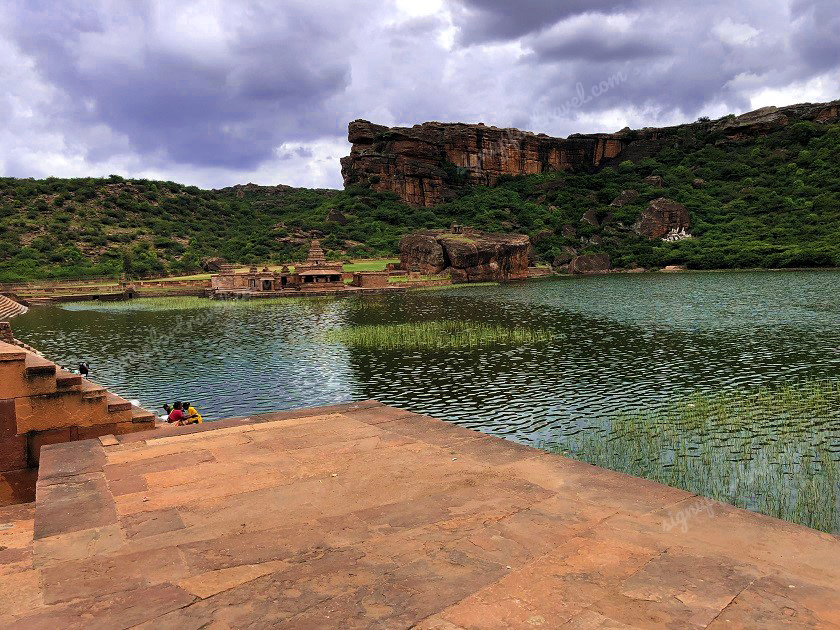
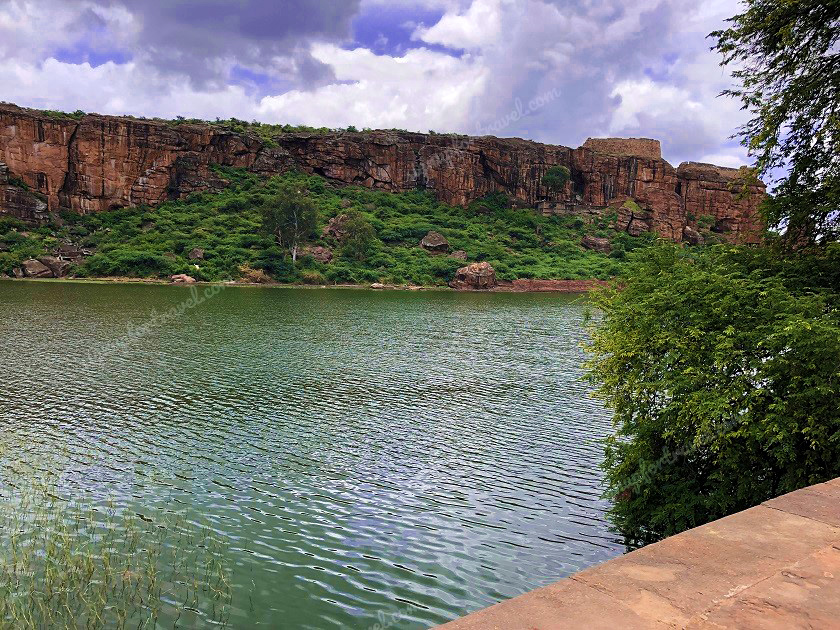
We could also see the Badami caves right in front on the other side of the lake. The main temple is dedicated to Lord Shiva although not much is left inside. There is another small complex which has carvings on its outer walls which resemble the ones found in the caves. These carvings served as a prototype before being carved inside the caves. The security guard was kind enough to explain a few things related to the temple. We paid him a small amount as our token of appreciation (though he did not ask for it).
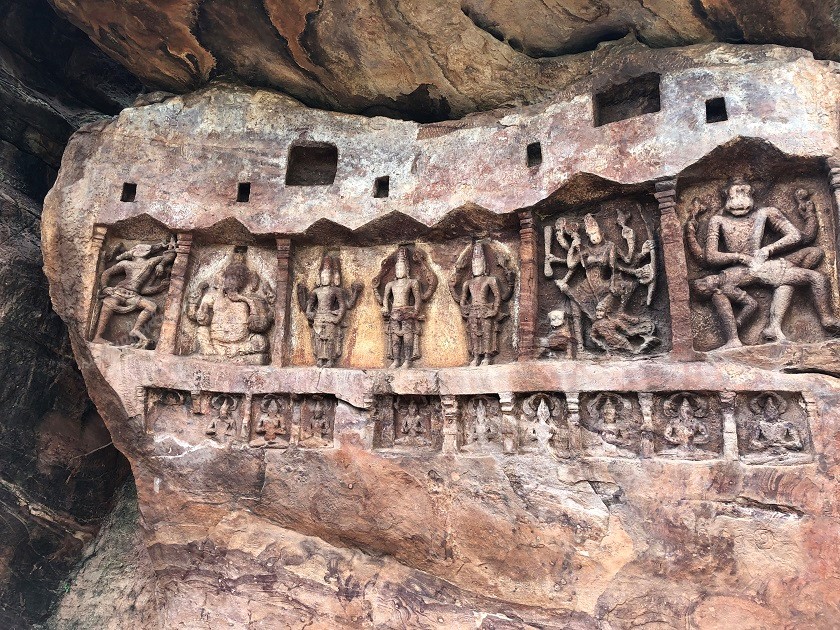
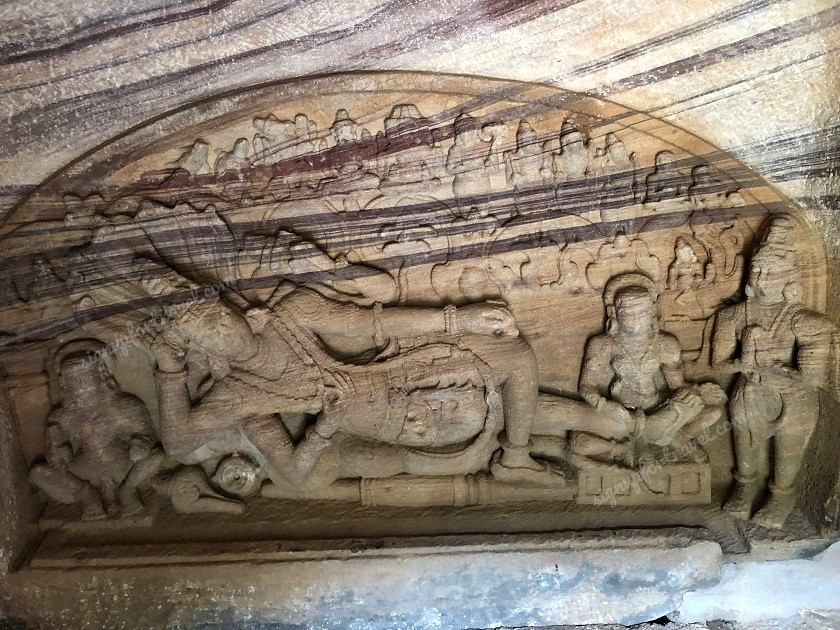

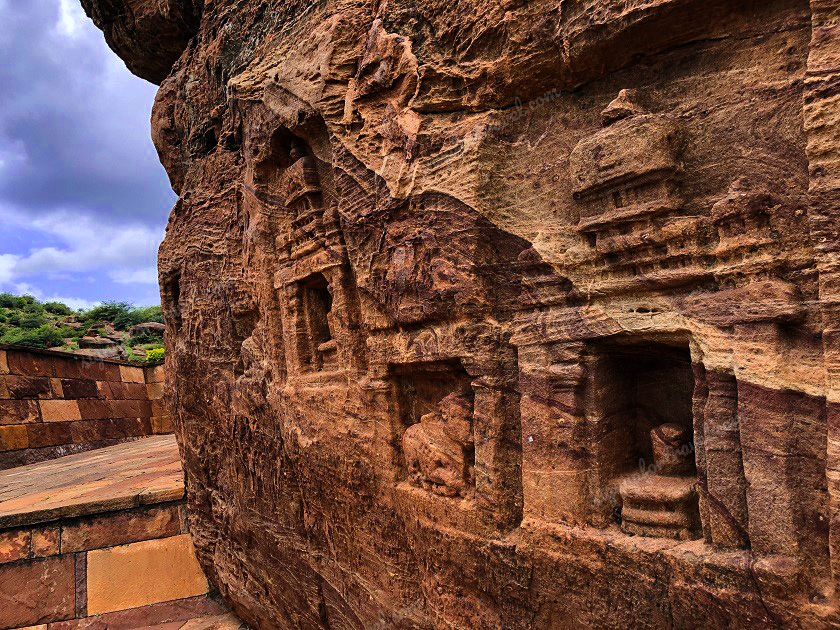
12. Return to Pune
The time was around 1 PM when we decided to call it time on our exploration. The heat was killing us. We came back to our hotel and took some rest and started the long ride back of 470 Km at around 2.30 PM.
The route taken was Badami-Kerur-Vijayapura-Solapur-Pune. On our return, for part of the way we took NH52 which is not that wide and does not have a divider, but the road was decent enough. We crossed the mighty Krishna River (a sight to behold) just before Vijayapura. This time we crossed it over the backwaters of the Almatti dam. The rain also caught up with us on our return just before we reached Vijayapura, making our progress a bit slow.
Once we reached Vijayapura it was an open and smooth highway. We stopped around 8 PM for a tea and snack break. We were excited to be back in Maharashtra as there were abundant hotels/restaurants all along the highway in stark contrast to what we experienced in Karnataka. After that, it was a non-stop ride in the dark (with a few small breaks to ease our pain in back) and we finally reached Pune safely around midnight.
13. Final thoughts
One thing that every true traveller doesn’t like is the last day of the trip and we were no different. But then, what we witnessed in the past few days was nothing like anything we had seen in our lives. If we just think about it, this was just a small trip of four days but then the amount that we absorbed made it seem like a lot longer.
History, when studied in classrooms might be very tedious but when we see it for real, the whole experience becomes awe-inspiring. From the magical city of Hampi to seeing the very old temples of Aihole, Pattadakal and Badami, it was a wonderful experience revisiting our glorious past.
Though the four days we spent there were not enough by any stretch of the imagination, we covered whatever we could in those four days and at the end of it we returned home satisfied.
Do read our previous blogs and leave us a comment down below for any kind of feedback or questions as we would love to hear from you.
Do show us some love by sharing the content with your near and dear ones.
Namaste 🙏


